If you decide to buy a Tesla, any Tesla, please consider using my Referral Code: https://ts.la/doug93556. You’ll get a US$100 Supercharger credit and I’ll get something, too. Thanks!
Floor Mats
The carpeting material in the Tesla Model 3 premium interior is rather flimsy. It doesn’t have the feeling of a fabric that will hold up to much wear and use. So I went on the hunt for floor mats and settled on two sources.
For the passenger-compartment floors (front and rear) I selected the 3D MAXpider mats for US$205. There was (and currently still is) a wait, but I did receive them within the timeframe I was quoted.
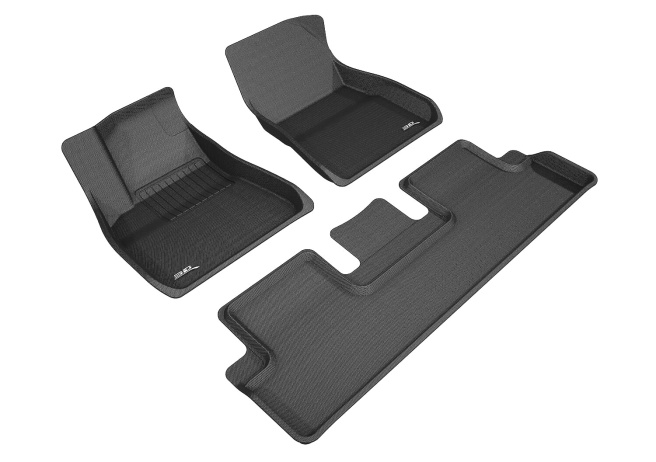
These mats aren’t plush. They’re fairly hard rubber, textured and sculpted to fit perfectly and with raised edges so the mats can actually constrain dirt and liquids. They’re very lightweight and stiff, so you can easily lift them out to just hose them off. I didn’t like the “3D” logos, so I (easily) removed them, although that leaves a dimple in the material. I prefer that to the glossy logos. I like these even more than I expected.
For the trunk and frunk, I decided to purchase the Tesla mats for US$130 and US$70, respectively. Like the MAXpider mats, these have raised edges and are lightweight and easily removable. For some reason, these Model 3 logos didn’t bother me, so I’ve left them on. The trunk mat has a notch for the loop that allows you to easily lift the hatch covering the deep storage well in the rear.
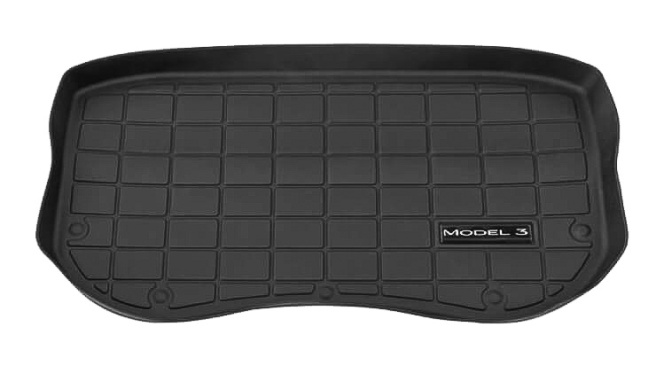
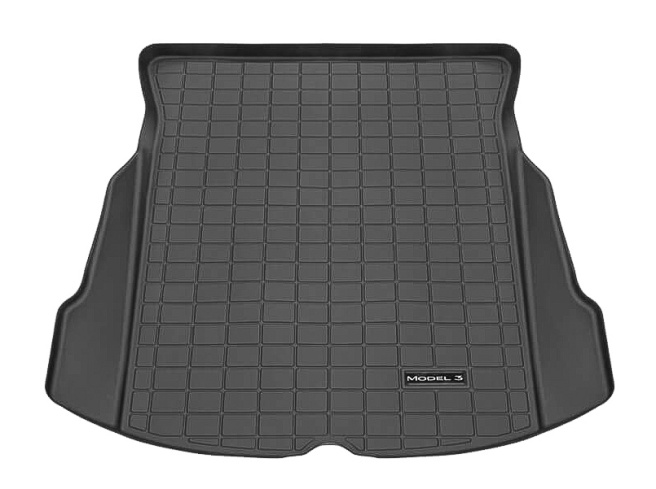
Both sets of mats are highly recommended. US$409 total, plus taxes and shipping (if any).
Kenriko’s Wraps
As much as I love my new Tesla Model 3, there are a few cosmetic things that cried out for modifications. And given that I wasn’t able to even drive the car for its first two months due to an injury, I spent much of that time making various “improvements”. Many of the mods are in the form of vinyl wraps, described below.
I searched the internets for options and finally settled on the vinyl-wrap kits from Kenriko, sold on Amazon.com. He’s a guy with a day job, so there are some delays in his updating Amazon’s inventory as well as fleshing out the options such as different materials (matte black, carbon fiber, etc.). The kits are very reasonably priced, all below US$30. Kenriko is very active (and responsive) on the Tesla Motors Club forum.
Center Console

I began with the center console. Like almost everyone I’ve spoken to, I found the stock glossy black finish to be a disaster. It shows every fingerprint, scratch and speck of dust. I considered carbon fiber and other vinyls, but ended up going with Kenriko’s Avery 900 Matte Black kit. (See his installation video.) Why the Avery matte black? Kenriko says (and he’s right) that the 3M M12 Matte Black scratches very easily. The Avery product (in this particular case) is more durable. But my main reason is that it looks so good with the dark Alcantara upholstery. It’s a DIY wrap, but I cheated. I had Juan Gomez install it when he wrapped the exterior of the car. Juan does a much better job of this than I do.
Door Switches

After getting the car back from Juan, I decided to tackle the door switches myself. For this one, I bought Kenriko’s 3M 1080 Matte Black kit. (Installation video.) Yeah, I know I just wrote that 3M Matte Black scratches, but it seems okay on the door switches, which aren’t as vulnerable or obvious as the center console. After installing the wrap, I decided to swap out Kenriko’s door-open buttons for glossy yellow vinyl. I originally hand-cut the pieces using Kenriko’s originals as templates. More on this later. (Original post with more info at https://goo.gl/c7Kuva.)
My Own Vinyl Cutter
Not only does Kenriko sell kits on Amazon.com, he also uploads free, open-source templates to github in both .ai (Adobe Illustrator) and PDF formats. You can easily download the PDF versions and then hand-cut your own materials, but some of the cuts are small and tricky. For best results, you’ll want a true vinyl cutter. Also consider that the cost of the vinyl is almost as much as buying one of Kenriko’s complete kits, so if you can live with the materials he offers, you’re better off just purchasing his kits.
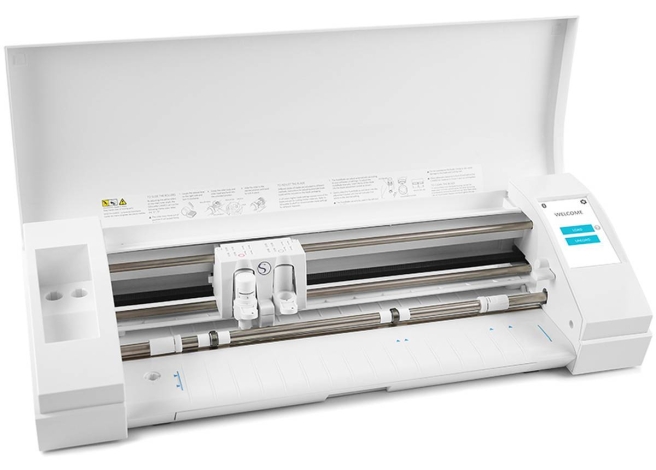
I decided I wanted to do more of this type of modification, so I decided to dive into the world of vinyl cutters. After a bit of research, I settled on a Silhouette Cameo 3 cutter. Yeah, I know US$200+, plus the materials — I could do all of this for far less by just buying kits. But hey…I didn’t say any of this was rational!
I then purchased a variety of vinyls including:
The standard Silhouette Studio software, which is free with the cutter, won’t open Adobe Illustrator or PDF files. For that, I upgraded to the Designer Edition. That’s US$49.99 if purchased from Silhouette, but I discovered you can buy it from Swing Design for US$20 less. The PDF files work fine as-is, but at the time I wanted to tackle the next project (door sills), Kenriko had only uploaded the Adobe Illustrator file to github.
Not wanting to pay monthly for Adobe Illustrator, I downloaded the free, open-source app, Inkscape instead. For my iMac, this also required X11, so I downloaded and installed XQuartz. At first, I tried opening the .ai files in Inkscape and saving as SVG files, then opening those in Silhouette Studio. That resulted in some scaling errors. Instead, I ended up exporting to PDF from Inkscape and opening the PDFs in Silhouette. Scaling correct!
One of my first self-cut projects was to replace the little yellow door-opening buttons (see above) with ones that have cleaner edges.
Door Sills
Armed with my trusty Cameo 3, I was ready to tackle the next project: door sills. Kenriko did the hard part, designing a template to cover the front-door sills with cutouts for the “MODEL 3” text. But I wanted two things he didn’t offer: Matrix Black vinyl — Carbon Fiber is more popular, but I like the matrix look better — and red lettering.
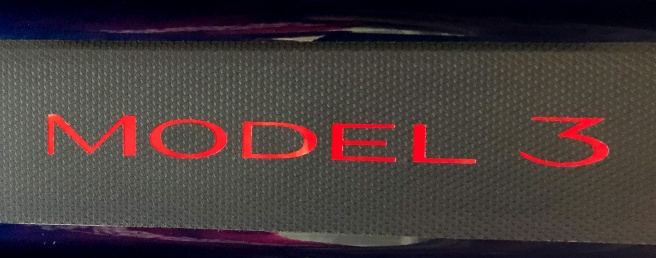
I downloaded Kenriko’s template in Adobe Illustrator format. I then made two versions: One just as Kenriko made it for the Matrix Black overlay, and another for the Gloss Dark Red vinyl that covers the full area but is just a bit undersized: about 2mm all around. I exported both in PDF format, opened them in Silhouette Studio, then cut the vinyl. The Matrix Black is quite a bit thicker and tougher than the red vinyl, so I had to run a few tests to get the settings right.

No, there isn’t normally a door-sill plate on the rear doors. This is a Kenriko “extra”.
What’s Next?
I’ve got at least two more wraps in the works: I want to cover the wood dashboard strip in Matrix Black and portions of the steering wheel in Matte Black, like the center console. I plan to wait for Kenriko to upload templates for these mods, since he does all that work with more care and patience than I’m likely to use. I plan to update this post once I’ve got those done.
Red Brake Calipers
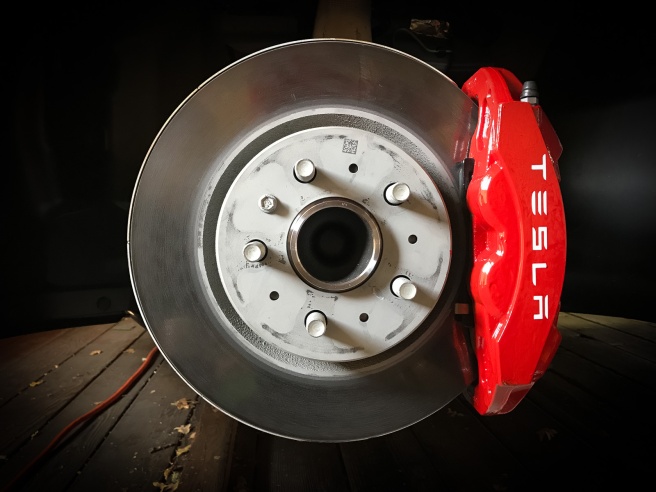
I’ve always liked the look of bright red brake calipers behind good-looking wheels. Even before I got my Tesla Model 3, I knew I wanted red calipers. I researched the options and found these:
- Unplugged Performance offers a complete replacement for rotors and calipers for $9,000. Beyond my budget.
- T Sportline in the Los Angeles area will paint them for you for $1,200. Still more than I wanted to pay. And I don’t live near L.A.
- EVANNEX sells a set of red caliper “covers” for $290. They look okay, but it’s a weird way to get the results. And even still a bit pricey.
- ForMyTesla.com offers a DIY kit of epoxy paint and decals for $79. Now we’re talking! (Their website is a mess. As of writing this, I could only get there via ForMyMercedes.com since the ForMyTesla.com link wasn’t working at all in my browser. Others don’t seem to have a problem with it however.) Note that if you don’t want the “Tesla” decals, you can buy the exact same kit for 1/2 the price at many places.
Needless to say, I went with the least expensive option.
Of course, any project like this is nothing more than an excuse to buy tools, and in this case the tools cost well more than the project itself. In my case, I needed the following to do the project. All but the last were found at the local Harbor Freight store:
- 21mm socket with 1/2″ drive – $3.99
- Breaker bar to remove the lug nuts – $12.99
- Torque wrench, up to 129 foot-pounds – $19.99
- 3-ton low-profile hydraulic floor jack – $129.99
- Wheel chocks – $7.99
- Jack adapter – $35. If the URL doesn’t work, search eBay for “Tesla Model 3 Jack Pad Adapter Lift Point Pad”.
Total for the project: $288.18 plus shipping and sales tax. Same price as the EVANNEX option and I end up with (a) better results, and (b) tools I will use in the future.
The jack adapter is very important. There are only four specific points at which you can jack up your Tesla Model 3 unless you want to start removing panels from beneath the car to expose suspension points at which you can support the 2-ton vehicle. Even then, those would be the “unofficial” points at which to lift the car. Plus, without a full lift or jack stands, I prefer not to work underneath a jacked-up car. You might be able to lift the car from one corner high enough to place a jack stand under the other point on the same side, but even then I’d need four jack stands and three more adapters. So I decided to do one wheel at a time.
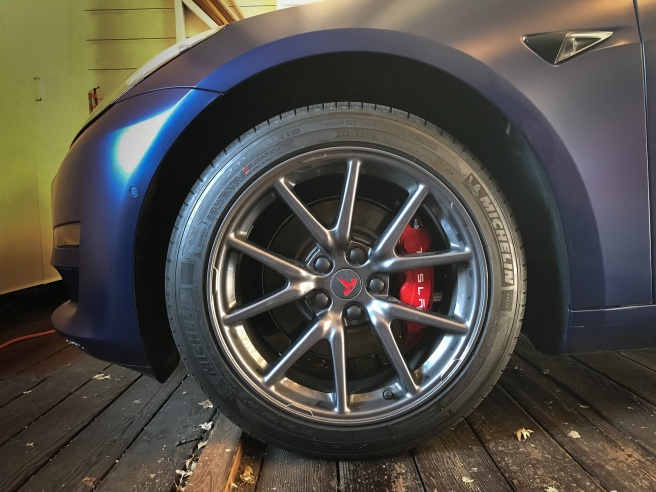
Here are the steps I took:
- Chocked the wheels on the opposite side.
- Used the breaker bar to loosen the lug nuts.
- Jacked up one wheel using the adapter.
- Removed the wheel.
- Used the spray cleaner provided with the paint kit to clean the caliper.
- Masked off areas not to be painted such as the disk, pads, dust cover, etc.
- Mixed 1/4 of the red paint and the epoxy “activator” using disposable eye droppers and a paper cup, neither of which are included with the kit, which is designed to be mixed and used all at once. You can use it for two hours before it cures.
- Painted a first coat using a disposable 1″ foam-rubber brush (the kit includes just one brush).
- Waited 15 minutes, then applied a second coat.
- Waited two hours, then installed the decal.
- Sprayed a protective coating (to keep the decal from rubbing off during washing) using some stuff I had in the house.
- Reinstalled the wheel.
- Waited 24 hours before driving.
The jack adapter has a magnet that holds it in place to the frame of the car. That’s great, but it’s too easy to forget about it after you lower the car. I solved this by attaching it to the jack using a piece of string so that when I remove the jack, the adapter always comes off with it.
[Note: I think the jack adaptor is a great thing to keep in your car in case you need roadside service, etc.]
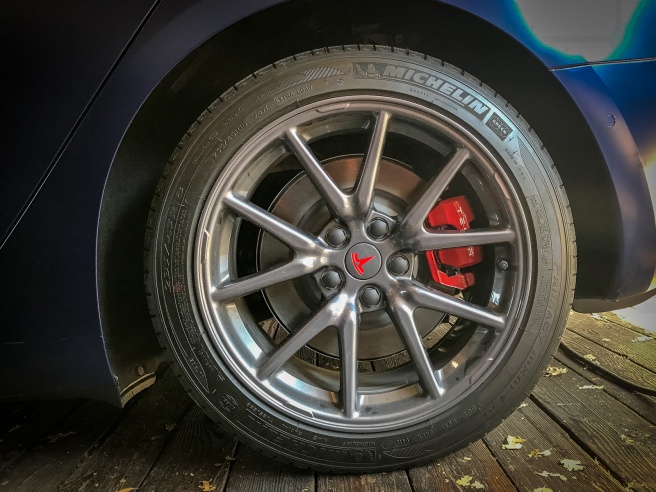
The kit from ForMyTesla.com was excellent. Good quality materials, good instructions and a fair price.
Because of the two-hour wait before re-mounting the wheels, this takes eight hours, plus the 24-hour wait before driving. Or spread it out over two days like I did. It’s actually less than one hour of work time per caliper.
Oh yeah…what about that red logo on the wheel hub? First of all, these are the standard 18″ wheels with the aero covers removed. I added Tesla’s Aero Wheel Cap Kit for $50. Then I finished it off with the red T-logo decals from Tesla Pride ($9.75 from Amazon.com).
The Overton Technique
My friend, Roxanne Bouché Overton (roxanne_overton on Instagram) has been developing a collection of techniques she calls Intentional Camera Movement or ICM. Many of her images are just that: moderately long exposures (perhaps 1/10 to 1 second) during which she moves the camera up, down, side-to-side, perhaps in a curved motion, forward/back or zoom in/out. As you can see from her Instagram feed, she’s become quite good at it.
But a few days ago I attended a presentation she gave, and at the end she showed the results of another variation on the technique. Here are two of her images. I think you can see why I was intrigued.
 Photo by Roxanne Bouché Overton
Photo by Roxanne Bouché Overton
 Photo by Roxanne Bouché Overton
Photo by Roxanne Bouché Overton
Based on what she explained, I decided to give it a try. Here are my first results:
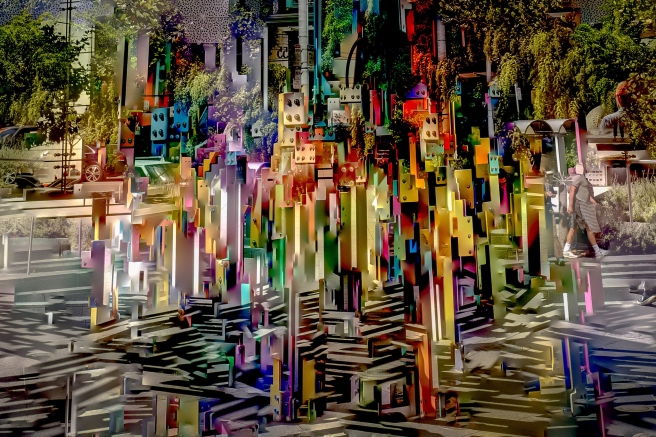 “Cityscape #1” by Doug Kaye
“Cityscape #1” by Doug Kaye
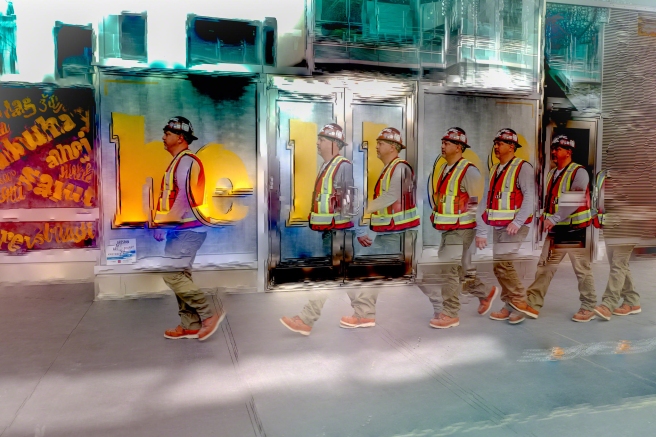 “Walk This Way” by Doug Kaye
“Walk This Way” by Doug Kaye
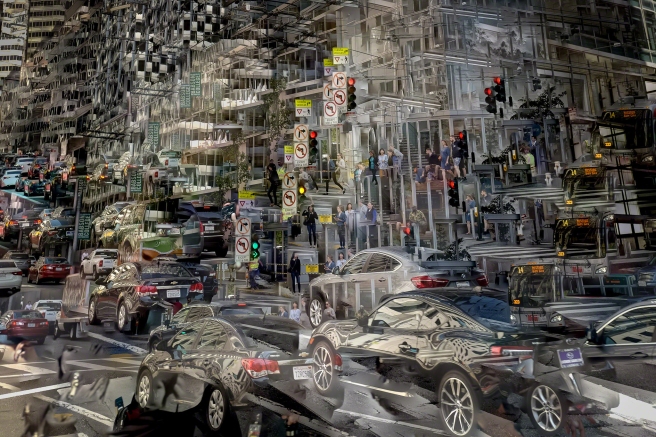 “Cityscape #2” by Doug Kaye
“Cityscape #2” by Doug Kaye
 “Bike 363” by Doug Kaye
“Bike 363” by Doug Kaye
So, how do you do this? It’s remarkably simple.
First are the exposures. Unlike Roxanne’s other ICM work, these are not long exposures, but rather traditional short-exposure shots. There are multiple handheld images. In the case of “Cityscape #1”, I photographed a street sculpture by walking around it, shooting about 20 images from all 360 degrees. Here are two samples of the individual images:
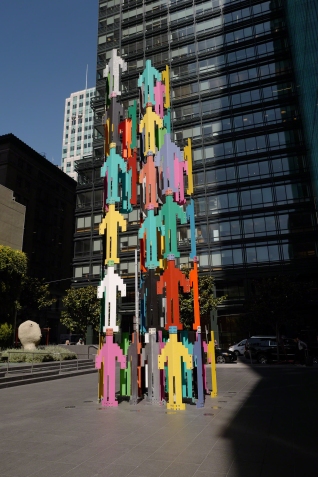

From Lightroom, I selected all the images, then [Photo…Edit in…Open in Photoshop as Layers]. Once in Photoshop, I selected all the layers, then [Edit…Auto-Blend Layers…]
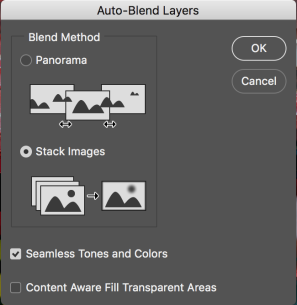
(Note that sometimes I check Seamless Tones and Colors, but other times it works better without.)
That’s it! Seriously. It’s almost embarrassingly simple. I flatten the image (merge the layers) and save. The resulting image is automatically returned to Lightroom.
What’s going on here? Auto-Blend is typically used for processing focus-stacked images, most often for macro photography. Photoshop creates a layer mask for each image (layer) then analyzes the overall image, one very small region at a time. For each region, it looks at each layer and determines which layer can provide the sharpest sub-image for that region. It then “masks in” that region on that layer. When the layers are merged, you have an image with the maximum sharpness in each region.
But that’s for focus stacking. In this technique, Photoshop is trying to do the same thing, but because the camera or subject have moved from one exposure to the next, Photoshop is merging parts of the subject that may not be in the same region from one layer to the next. You never quite know what you’re going to get, but with practice you can get an idea of what subjects, angles, lighting and lenses will yield the best results. (All of my images above were JPEGs captured with a Leica Q, 28mm, in full-auto mode.)
Not all resulting images are made with 360-degree coverage. For example, for “Walk this Way” I barely moved the camera between exposures. For “Cityscape #2” I purposely moved it a bit up/down, left/right between exposures. And for “Bike 363” I moved about 180 degrees around the motorcycle. In all cases, I’ve cropped the resulting images to emphasize the most interesting portion of the results.
Check out Roxanne’s other work and give this technique a try. It’s a lot of fun. And let me know how it goes!
Front License Plate Holders
The Tesla Model 3 comes with a bracket for attaching a front license plate. It’s a simple gadget you affix to the front of the car using an adhesive. There’s just one problem: the car has very nice front-end lines that are ruined by attaching the plate. At least in my opinion and those of many others.
Here in California, a front license plate is required. You can get a “fix-it ticket” for $114. Supposedly — I haven’t tried it — you can then attach your plate, take it to the DMV (or perhaps any local police department) have them inspect the vehicle, and have the ticket reduced to $20. From what I hear, most of these tickets are issued by parking-meter patrols.
I’m not planning to permanently attach my front plate, so to prepare for receiving such ticket(s), I went looking for the best removable front license-plate frame. Here are some I found:
- The Law. $134.99 from Torklift Central (or at a higher price from elsewhere). It’s “designed for no-touch carwash only”, which is probably true for most or all of these options. My #1 concern is that the plate is mounted in front of the grille. And while the Model 3 doesn’t have a traditional (engine) cooling system, it does have a radiator and coolant system for the main batteries and MCU (computer).
- Sto n Sho. $94.99 from Big Mikes Performance Parts. I liked the price and the fact that the plate is so easy to remove. However it requires drilling into the underside of the bumper cover (not too big a deal), but also that it extends about an inch below that bumper cover. I’m already scraping the ground when I drive into my garage. This would make that much worse. Plus, like The Law, this bracket blocks the grille.
- Platypus. $93.00 from CravenSpeed. This is a pretty good solution. The plate is easily removable and when on, it doesn’t block the air intake. It looks a little weird, being mounted off to the side. But if your goal is only to attach the plate for the sake of an inspection, this might be the best (and least expensive) option. The Platypus attaches to the tow-bolt, which on the Model 3 is on the far-left (driver’s) side of the grille. CravenSpeed claims it blocks neither the cooling nor the ultrasonic sensors. And it has a quick-release feature. But did I mention that it looks a little weird?
- Evannex. $99.95 from Evannex, who also sells The Law, but at a higher price than Torklift Central. This is a very simple device. It uses adhesive to attach to the front bumper cover, but like The Law and the Sto n Show frame, this one blocks the grille. Another no-go for me.
- The Bandit. $119.00 from 1975 Creations. This is the one I ended up buying and so far, I’m glad I did. First of all, The Bandit doesn’t block the grille or any sensors. It bolts onto the grille, but has arms that reach upwards, positioning the plate above the grille in the same position as Tesla’s own adhesive mount. Second, it’s centered so it doesn’t look weird. Third, it’s removable, although not as easily as The Law, Sto n Show or the Platypus. Still, it’s easy enough to remove and replace and I appreciate the quality of the CNC-machined materials, the quality of the attachment hardware and the completeness of the package including tools.
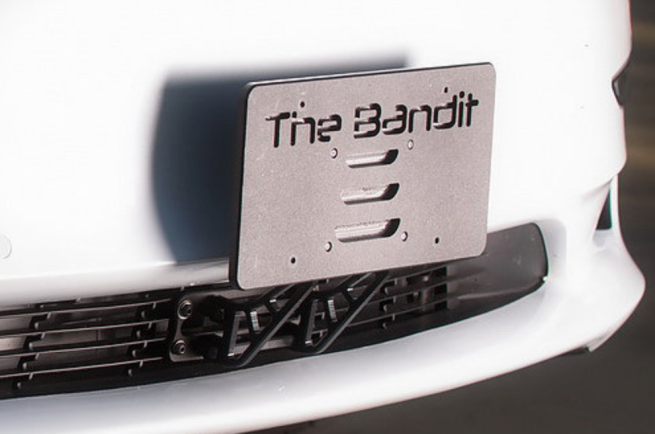
Door Latch Releases
One common complaint about the Tesla Model 3 is the door latch releases, particularly in the front seats. There are no frames for the windows. When fully raised, the glass just presses into a soft black rubber seal. When you open the door from the exterior or by pressing the interior door-release button, the window first drops a bit to protect the rubber, then the door opens.
But these are electromechanical functions that won’t work if the 12vdc power is off. For this reason, Tesla provides a purely mechanical door release in the front seats in case of emergency. You lift up on the lever and the door opens, but without the benefit of first lowering the window. Done often enough, and there’s a chance you’ll damage the rubber seals.
The problem is that if you reach for the latch release where you’d most likely expect it to be, you’ll actually pull the emergency mechanical release. The proper button simply isn’t where most people, familiar with other car doors, expect it to be. If you own a Model 3, you get used to it right away, but occasional passengers or other drivers tend to pull the mechanical release instinctively.
Rather than constantly explaining how to open the door from the inside — something I shouldn’t have to do to begin with — I decided to find an easier way to communicate with Tesla Model 3 newbies.

I’m a big fan of the vinyl kits by Kenriko. I’ve installed one on my center console to solve the problems of scratches and fingerprints. (Plus, I didn’t like the glossy finish.) I plan to install Kenriko’s kit to cover the wooden dash (when it’s available), the steering wheel and the door sills. I also installed the door trim wrap kit, shown above.
But for the door-release button, I used Kenriko’s piece as a template and hand-cut a piece of yellow vinyl. Now all I have to do is say, “Press the yellow button to open the door.” I’ve got them on all four door-release buttons and they work great. It looks rather garish in the photo above, but that’s because I wanted to lighten the image to show the dark materials. In reality, it’s not this bright, but it’s still bold enough to be seen, even in a darkened garage.
EV Tax Credits, Rebates and HOV Decals
There are a variety of financial incentives to buying an electric vehicle (EV) in general and a Tesla in particular. [This is a US- and California-centric post.]
Federal Tax Credit
The U.S. federal government and a number of states offer financial incentives, including tax credits, for lowering the up-front costs of plug-in electric vehicles (EVs).
The federal Internal Revenue Service (IRS) tax credit is for $2,500 to $7,500 per new EV purchased for use in the U.S. The size of the tax credit depends on the size of the vehicle and its battery capacity. A 2018 Long-Range Tesla Model 3 qualifies for the maximum $7,500 credit. (To find out specific tax credit amounts for individual vehicles, visit FuelEconomy.gov’s Tax Credits for Electric Vehicles and Tax Credits for Plug-in Hybrids pages.)
This tax credit is available until 200,000 qualified EVs have been sold in the United States by each manufacturer, at which point the credit begins to phase out for that manufacturer. Tesla has just recently shipped their 200,00th car, and according to Electrek.co, Tesla buyers will lose the full $7,500 credit by the end of 2018 unless the law is changed, hitting $3750 for the first half of 2019 and $1875 in the second half of 2019.
To claim the credit, fill out IRS Form 8936, Qualified Plug-in Electric Drive Motor Vehicle Credit. For vehicles acquired for personal use, report the credit from Form 8936 on the appropriate line of your Form 1040, U.S. Individual Income Tax Return. For vehicles purchased in 2010 or later, this credit can be used toward the alternative minimum tax (AMT). To learn more about the law, visit the IRS’s Plug-in Electric Drive Vehicle Credit webpage.
CAV Decals and HOV Lane Usage
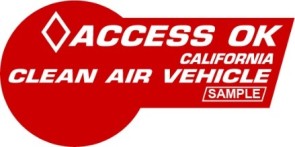
The California Clean Air Vehicle (CAV) program authorizes a qualifying vehicle that meets specified emissions standards to be issued a CAV decal to allow single occupancy use of High Occupancy Vehicle (HOV or carpool) lanes. The fee for a clean air vehicle decal is $22. Apply for your stickers from the DMV.
The California DMV is now issuing a new red decal for all qualifying vehicles that will be valid until January 1, 2022. For a vehicle purchased on or after January 1, 2018, the DMV cannot issue a CAV decal to an applicant who has received a consumer rebate through the Clean Vehicle Rebate Project (CVRP), below.
Clean Vehicle Rebate Program (CVRP)
California residents may also quality for a $2,500 rebate under the Clean Vehicle Rebate Program (CVRP), depending upon the type of vehicle and your annual income.
Depending on your income, you may not qualify for the CVRP or you may have to choose between the CVRP rebate and the CAV decals. For EVs (as opposed to fuel-cell vehicles) if you’re above the income limit, CAV decals are your only choice. An applicant whose gross annual income is above specified thresholds must choose between a CAV decal or a CVRP rebate.(See Question #6 in the FAQs.) The income limits are
- 150,000 for single filers
- $204,000 for head-of-household
- $300,000 for joint filers
PG&E Clean Fuel Rebate
Pacific Gas & Electric also offers a $500 rebate if you buy or lease a new EV. The application procedure is simple and the rebate checks arrive within just a few weeks.
Those CAV Decals!
The federal $7,500 tax credit (which you claim on your next-year tax filing) and the $500 PG&E rebate are no brainers. If you’re below the income limits, you’ll have to choose between the $2,500 California rebate or the CAV decals.
Where I live in the San Francisco Bay Area, CAV decals are of questionable value. The HOV lanes are usually as crowded as the non-express lanes due to carpoolers, EVs and scofflaws. But there’s something about preserving the option that makes the CAV decals “nice to have”. The problem is that they’re particularly ugly and you have to apply four of them in a variety of specific locations on your vehicle. For a car like mine, where I’ve modified the finish, removed logos, blackened the chrome, etc., it’s a real shame to mess up the look of the car with decals. Bright red stickers on a very plain, matte blue car? Nah, I don’t think so!
The folks at RPMTesla, and others, have come up with a pretty good compromise solution. Rather than attach the CAV Decals directly to your paint or (in my case) vinyl wrap, you can apply the decals to pre-cut pieces of clear vinyl, which you then apply to your car. This way, you can remove the decals at any time without damaging either the decals or the car (or wrap) and even re-apply the decals later. The kit from RPMTesla costs only $19.00 plus shipping. ($24 total to California.)
Personally, I’ve purchased the RPMTesla kit and the CAV decals, but I have yet to put them on the car. Not sure if I will or not. At least I have that option. I’ve also received the $500 PG&E rebate and will apply for the full $7,500 federal tex credit on my 2018 tax returns. Together, these bring the cost of my car from $56,000 down to only $48,000 plus tax and license fees.
Configuration
On March 31, 2016, I went to the local Tesla store to plunk down a $1,000 deposit on the long-anticipated Model 3. No one had seen one, let alone driven one. There was a line out the door and down the street and I soon learned it wasn’t moving much. There were probably 100+ people in front of me, so I left, went home, and made my deposit from home later that evening. I was probably more than #100,000 of the 180,000 who gave deposits in those first 24 hours, so I figured I’d be waiting a while.
In March 2018, 24 months after all those Day One deposits, it looked like Tesla was getting ready to deliver Model 3s to new customers. They had been slowly delivering cars to some employees and existing owners of other models for the previous six months or so. Hoping I’d get to configure my car soon, I rented a Model 3 for 24 hours from a Tesla employee via Turo. My wife and I ran some errands and put about 100 miles on it. The car was everything I’d hoped for.
26 months after paying the deposit, and after checking the Tesla website many times each day, I discovered I could now configure my car. Of course I’d been planning my configuration for some time, and I was pleased to discover that my chosen config was identical to the first version of the car Tesla was producing. It would be the only configuration (except for color, wheels, interior and autopilot options) available for the first three months.
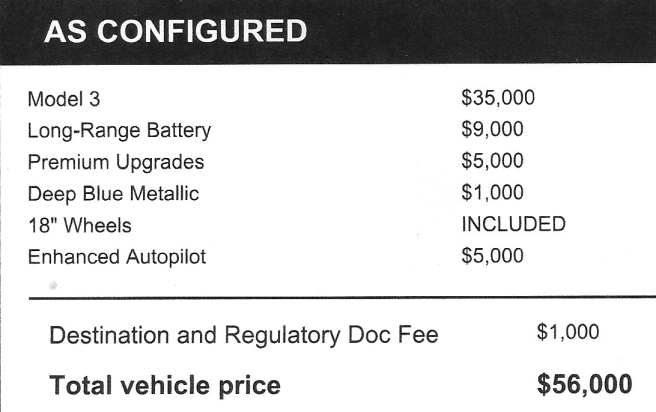
You can see the config from the delivery sticker.
- Basic Model 3 with Rear Wheel Single-Motor Drive (standard). 0-60mph in about five seconds. $35,000
- Long-Range Battery. 310 miles vs. 220miles for the standard battery. $9,000 upgrade.
- Premium Upgrades. Power, heated seats; center console; premium audio system (excellent!), tinted glass roof; dimming/folding/heated side mirrors; driver profiles; LED fog lamps. $5,000 package.
- Deep Blue Metallic paint. An extra $1,000 for those shiny little flakes.
- 18″ Standard Wheels with the removable Aero covers.
- Enhanced Autopilot. $5,000. Doesn’t include the future Full Self-Driving Capability, but does include (today!) Auto Lane Change, Autosteer (stay in lane), Traffic-Aware Cruise Control (great for stop-and-go traffic), Autopark (parallel and back-in) and Summon (in and out of the garage, for example).
- Total $56,000 plus tax and license.
So what didn’t I get?
- Full Self-Driving Capability. It’s a $3,000 increase, or pay $5,000 to update at a later date. This is a “future” feature. It doesn’t exist yet. Given the complexity of the task and all of Tesla’s many delays, I figure I might not still own the car by the time they offer this. So I opted out at this time.
- Dual-Motor All-Wheel Drive. 0-60mph in about 4.5 seconds. $4,000 increase. I don’t need to drive in snow, mud, etc.
- “Performance” Dual-Motor All-Wheel Drive. 0-60mph in 3.5 seconds. A $15,000 upgrade over the base price or $11,000 more than the non-performance AWD version. I had driven a basic rented Model 3 two months prior, so I knew the basic car was plenty fast enough for me.
- 19″ Sport Wheels. $1,500 upgrade. The standard 18″ wheels offer a smoother ride. Besides, I like the looks of both the standard Aero covers as well as the standard wheel that’s underneath if you remove the Aeros.
- Premium White Interior. $1,500 upgrade. White? Really?
And what do I think after three months (although admittedly, I still haven’t driven my own car)?
I’m quite happy with the choices I made. The only one I even question is the $9,000 long-range battery. That’s a big chunk of change, particularly considering that the 220-mile battery would probably be just fine for me except for 4-6 days per year when I might make a long trip to Oregon or Southern California. That standard battery still isn’t supposed to be available for another 6-9 months (ie, 2019Q1 or Q2), and since my old car (a Lexus 450X) was totaled in May, I’d have had to buy something else in the meantime. All things considered, I’m very happy to have the long-range batteries.
My Tesla Blog
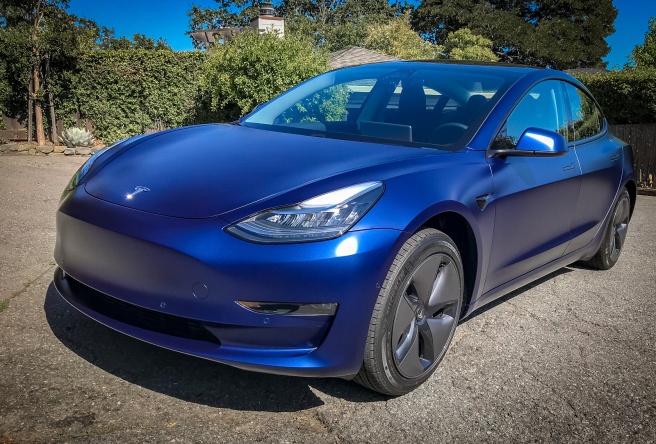 My 2018 Tesla Model 3
My 2018 Tesla Model 3
It’s been more than two years since my last blog post. So why now? And why Tesla? The short answer is that while stuck at home recovering from a nasty automobile accident, I’ve learned (and continue to learn) quite a bit about the new Tesla Model 3. I have pages upon pages of notes that I’ve decided to re-purpose as an ongoing series of blog posts and articles.
The detailed introduction…
With the rapid growth of social media, the popularity of blogging has steadily waned. Two years ago, all my posts were about photography. Occasionally, I posted a long-form article about something I’d learned, but most of the posts were in conjunction with my YouTube and audio podcast photography gear reviews, first on All About the Gear (on the TWiP network) and then with Gordon Laing on the Cameralabs Photography podcast. Over time, YouTube became increasingly important, and interest in the blog versions of my reviews — really not much more than links to YouTube — slowly faded. And besides, I’ve been so busy with the reviews and with teaching photography, Lightroom and Photoshop, I didn’t have much to say.
For the past three months, my wife and I have been recovering from a head-on car crash. Our injuries were quite serious: broken necks, broken sternums, broken ribs and (in my wife’s case) a badly broken wrist. The accident was May 4, 2018. I’m still confined to a cervical collar and my wife’s wrist is still in a cast. Bottom line: although we’re healing, neither of us can drive so we’re remarkably homebound and getting bored and grumpy. But we’re seeing the light at the end of the tunnel. My need to do something probably encouraged my return to blogging.
Okay, so back to Teslas…
On March 31, 2016 I, like many others, put down a $1,000 deposit on a Tesla Model 3. I had previously driven a Model S and even had a deposit on a Model X. But I was never happy enough with either of these cars to buy one. Sight-unseen, however, I was pretty sure the Model 3 would be the right car for me. So I waited. And waited.
Knowing that I’d soon be able to place an order or request a deposit refund, I rented a local Model 3 in March via Turo. No way I was going to order a new car without having driven one and Tesla had no demo cars for test drives. I loved it and placed a firm order as soon as Tesla notified me I could. So I waited.
Our accident was May 4. Eight days later I was released from the hospital, but was told I’d be in the collar and out-of-commission for at least 12 weeks. Sure enough, just two weeks after getting home I got the call from Tesla. “Your car is ready. You and your wife must both sign the documents and you need to pick it up here in Fremont [60 miles away] in two days. Otherwise, you’ll forfeit your deposit and lose your place in line.”
I explained our situation — we could barely walk — and said there was no way we could be in Fremont in two days. The rep said he’d get back to me. I posted our dilemma on social media, where a few thousand people read about it and hundreds left comments.
The next day, the rep called with the news that his manager had a change of heart. Instead of our traveling to Fremont, Tesla would now deliver the car to me, at my home and my wife didn’t have to sign the documents after all. “How’s tomorrow?”
On May 30, 2018 I took delivery of a gorgeous Deep Metallic Blue Tesla Model 3 with 66 miles on the odometer. The Tesla employee who delivered it, took Uber back to Fremont.
If you’ve ever been stuck at home for an extended period for health reasons, but been in pretty good shape overall, you know how bored and anxious you become. I can’t go places without rides from friends, Uber or Lyft and because we live atop a hill that’s too steep and long for me to walk up, I’l relegated to sitting at home in front of screens. And you know what that means: web browsing and shopping!
The Model 3 is sitting in the garage with just 247 miles on it (none of them driven by me) after two months. But it hasn’t been neglected. The car has been wrapped in vinyl, ceramic coated, outfitted with a fancy new front/rear dashcam and generally been adorned with almost every possible aftermarket add-on from decals and “performance” pedal covers to floor mats. The only thing that has saved me so far is that the car is relatively new and a lot of aftermarket accessories haven’t been released yet. If it’s available, I’ve probably bought one.
In the blog posts to follow I will document some of the many things I’ve learned about the Tesla Model 3. There’s nothing new here, but I hope to present it topic-by-topic with plenty of links to other sites so that these blog posts become a valuable resource for you and for me. Hope you enjoy it.